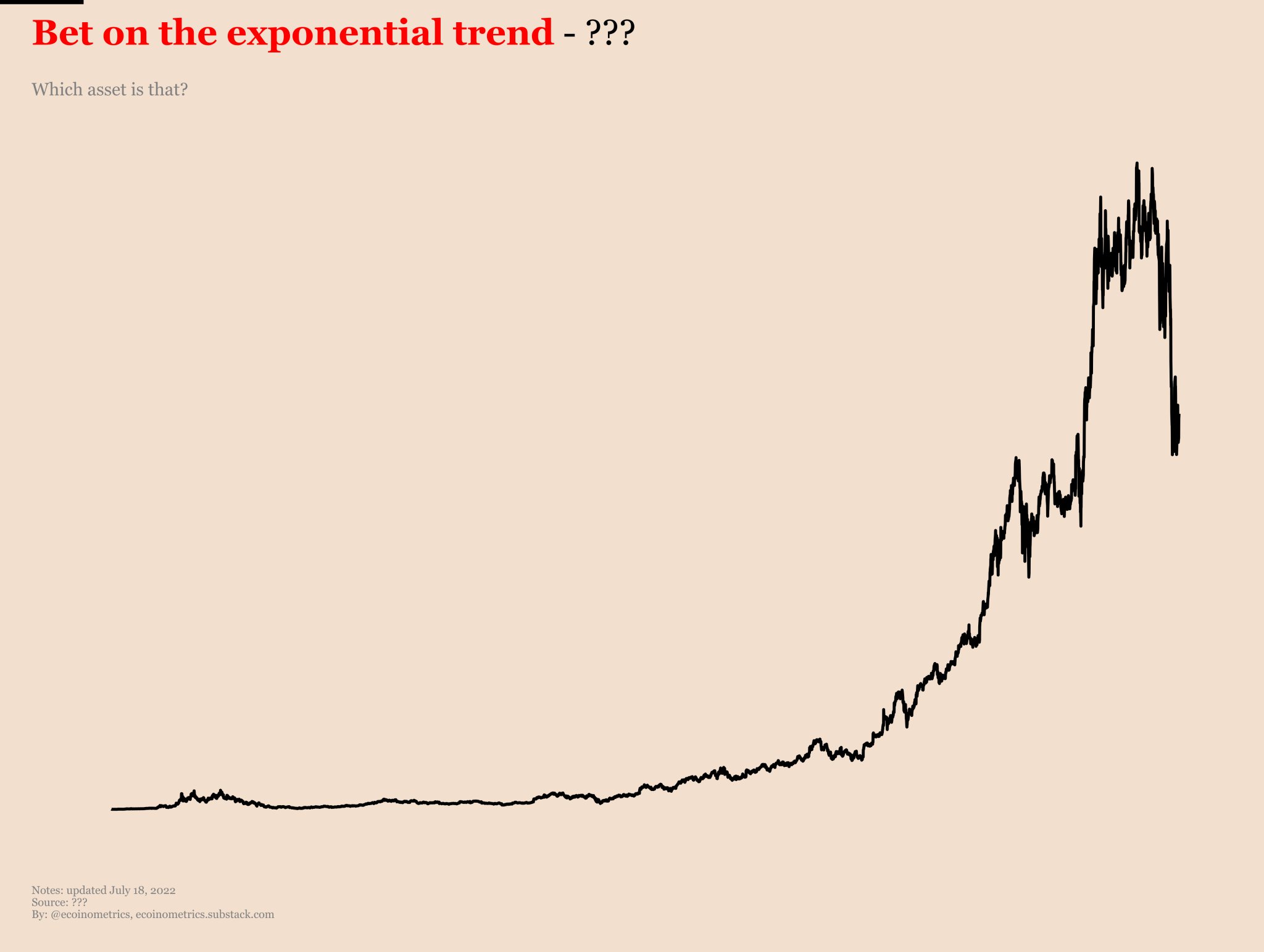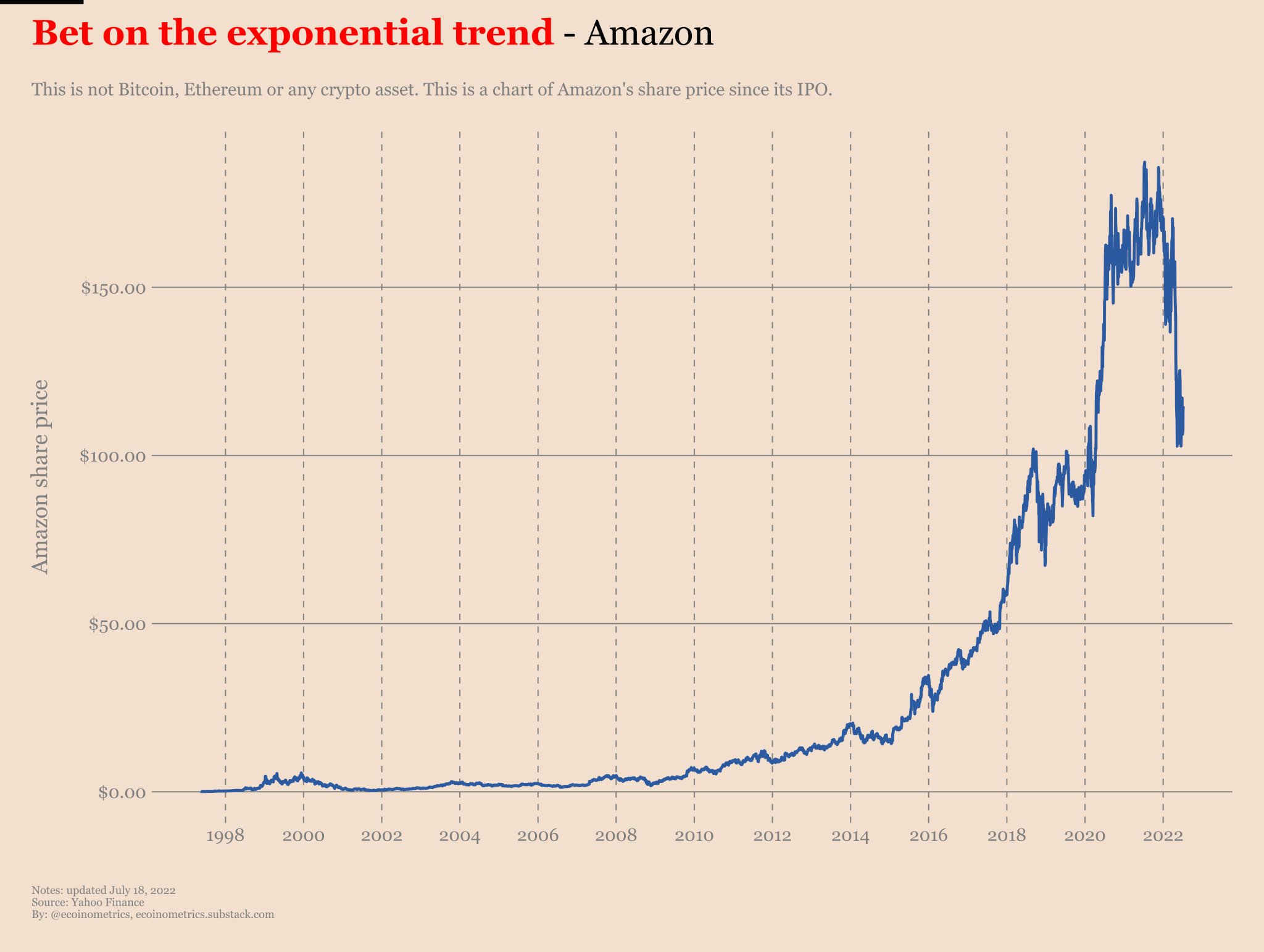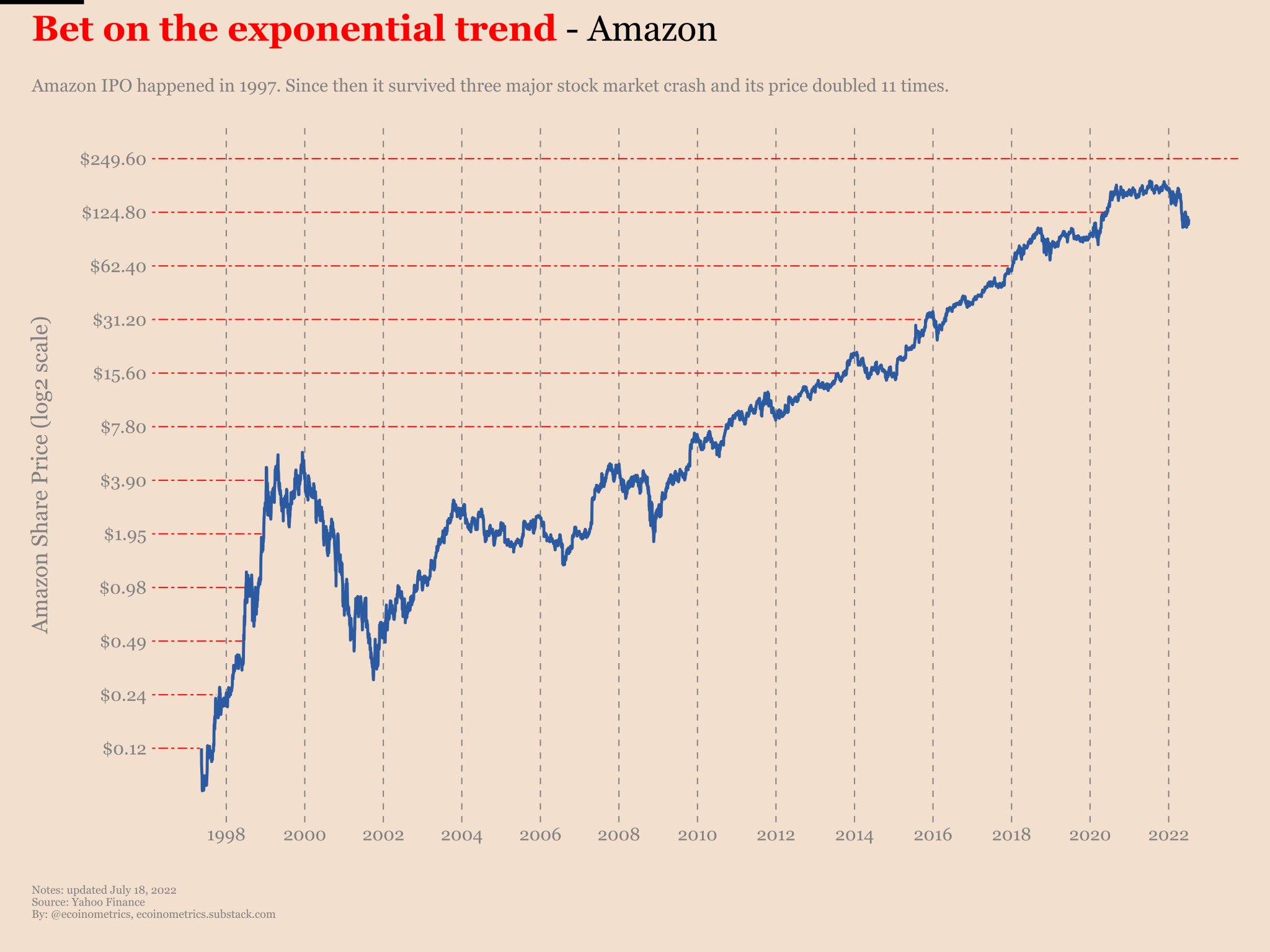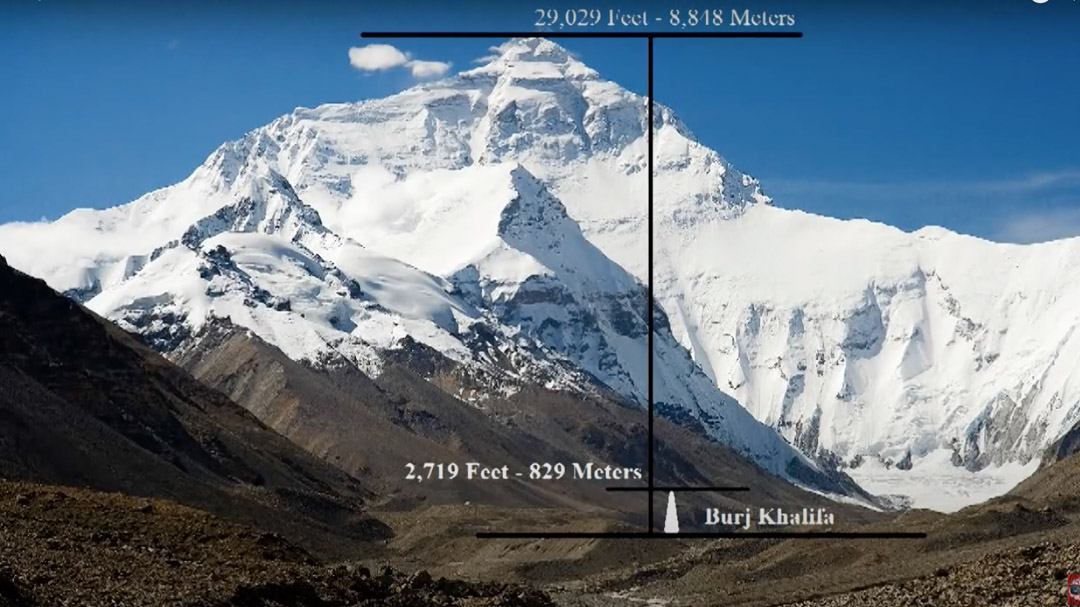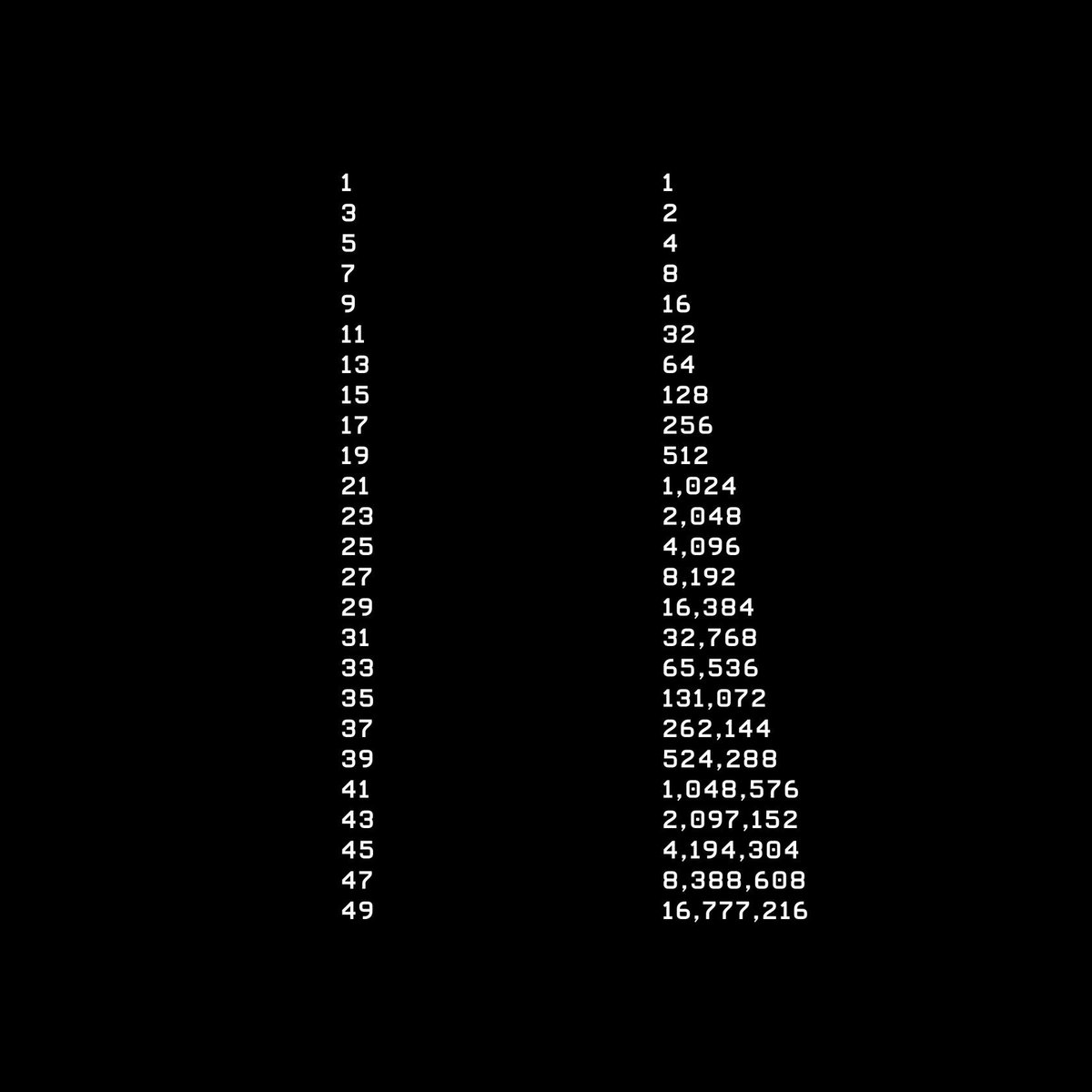Thread
When you think you are late, you probably aren't.
I'm talking about investing in the exponential age of course.
Let me give you an example.
Do you know what this chart is?
I'm talking about investing in the exponential age of course.
Let me give you an example.
Do you know what this chart is?
I'll give you some hints:
- This is a price evolution chart.
- It is using a linear scale.
- It covers several years.
- It isn't Bitcoin.
Any idea?
- This is a price evolution chart.
- It is using a linear scale.
- It covers several years.
- It isn't Bitcoin.
Any idea?
Ok, well there you go, this is a chart of Amazon's stock value since its IPO in 1997.
Check it out with the labels.
Check it out with the labels.
The total return since the IPO is 115,000%.
That's a lot.
So we might as well use a log scale to see what's really going on.
That's a lot.
So we might as well use a log scale to see what's really going on.
Now this is a log2 scales which means that every break you see on the vertical axis of this chart corresponds to a doubling of the stock value of Amazon.
Since the bottom of the Dotcom crash in 2002, Amazon has seen its share price double roughly every two years.
Since the bottom of the Dotcom crash in 2002, Amazon has seen its share price double roughly every two years.
That means if you had invested $10k on Amazon at the bottom of the Dotcom crash you would now have $5m.
Of course Amazon was down 90% from its all time high.
So chances are you would have thought it is too late...
Of course Amazon was down 90% from its all time high.
So chances are you would have thought it is too late...
If you had invested $10k in Amazon a few years later during the Great Recession it would now be worth $800k.
But you probably wouldn't have because the future is too uncertain during a recession…
But you probably wouldn't have because the future is too uncertain during a recession…
If you had invested $10k in Amazon in 2012 it would now be worth $160k.
But in 2012 Amazon was already a $100bn company by market cap. So for sure it is too late, they are going to start hitting diminishing returns…
But in 2012 Amazon was already a $100bn company by market cap. So for sure it is too late, they are going to start hitting diminishing returns…
I hope you start to see a pattern here.
What we are really talking about is missing the exponential trend.
And the reason for that is most people have the wrong intuition about exponential growth.
What we are really talking about is missing the exponential trend.
And the reason for that is most people have the wrong intuition about exponential growth.
Take this classical example.
A piece of paper is typically 2mm thick.
How many times do you need to fold it on itself to make something as high as Mt Everest?
A piece of paper is typically 2mm thick.
How many times do you need to fold it on itself to make something as high as Mt Everest?
The answer is only 27 times.
Every time you fold the paper you double its thickness.
At the beginning it doesn't look like much.
Fold 1, 4mm
Fold 2, 8mm
Fold 3, 16mm
Every time you fold the paper you double its thickness.
At the beginning it doesn't look like much.
Fold 1, 4mm
Fold 2, 8mm
Fold 3, 16mm
But by fold 24 you have already reached a thickness of 858m.
That's taller than the Burj Khalifa tower.
Two more folds and you get to about half the height of Mt Everest.
That's taller than the Burj Khalifa tower.
Two more folds and you get to about half the height of Mt Everest.
Two more folds again and you have a piece of paper 13km thick which is taller than Mt Everest.
That was quick.
This is the big difference between linear and exponential growth.
+2 vs x2 as @JackButcher would put it.
That was quick.
This is the big difference between linear and exponential growth.
+2 vs x2 as @JackButcher would put it.
As we have seen on the example of Amazon, some assets grow in value at an exponential rate.
As a matter of fact any asset whose value is based on the combination of technology and network effect is susceptible to experience exponential growth.
As a matter of fact any asset whose value is based on the combination of technology and network effect is susceptible to experience exponential growth.
The beauty of those assets is that you don't need to make a huge initial investment to generate outsized dollar returns.
Even 2mm folded onto itself a few times will get you on top of Mt Everest.
Even 2mm folded onto itself a few times will get you on top of Mt Everest.
And as a side effect that means you don’t need to have great stock picking skills to bet on the exponential trends.
Since even a small amount invested early gives you massive returns you can afford to spread your bets and increase your chances of riding the big wave.
Since even a small amount invested early gives you massive returns you can afford to spread your bets and increase your chances of riding the big wave.
This is the fundamental shift you need to make to be a successful investor in the exponential age.
Your job is to identify those exponential trends and ride them efficiently.
Most of the time that means focusing on the big picture instead of getting stuck in the details.
Your job is to identify those exponential trends and ride them efficiently.
Most of the time that means focusing on the big picture instead of getting stuck in the details.
Alright, that's it for today!
If you want to read more about macro economics, digital assets and investment strategies backed by data go subscribe to the Ecoinometrics newsletter.
ecoinometrics.substack.com/
If you want to read more about macro economics, digital assets and investment strategies backed by data go subscribe to the Ecoinometrics newsletter.
ecoinometrics.substack.com/
If you are looking for a starting point, we discussed dollar cost averaging vs lump sum investing for exponential trends over here.
ecoinometrics.substack.com/p/ecoinometrics-how-to-invest-in-the
ecoinometrics.substack.com/p/ecoinometrics-how-to-invest-in-the
We also recently looked at 80 years of history to find out which assets you need to own to beat inflation over different time horizons. You might want to check out this one too.
www.ecoinometrics.com/where-should-you-invest-to-beat-inflation/
www.ecoinometrics.com/where-should-you-invest-to-beat-inflation/
And don’t forget to follow @ecoinometrics so you don’t miss the charts and the latest articles.
If you want to go further down the rabbit hole of the exponential age and what it means for your portfolio I also recommend you go checkout @RaoulGMI.
This one is a good starting point:
This one is a good starting point:
And if you want more about Amazon I highly recommend you checkout the always excellent @AcquiredFM podcast.
Their most recent episode is telling the story of Amazon dot com.
Their most recent episode is telling the story of Amazon dot com.
Mentions
See All
Raoul Pal @RaoulPal
·
Aug 21, 2022
Great thread!
